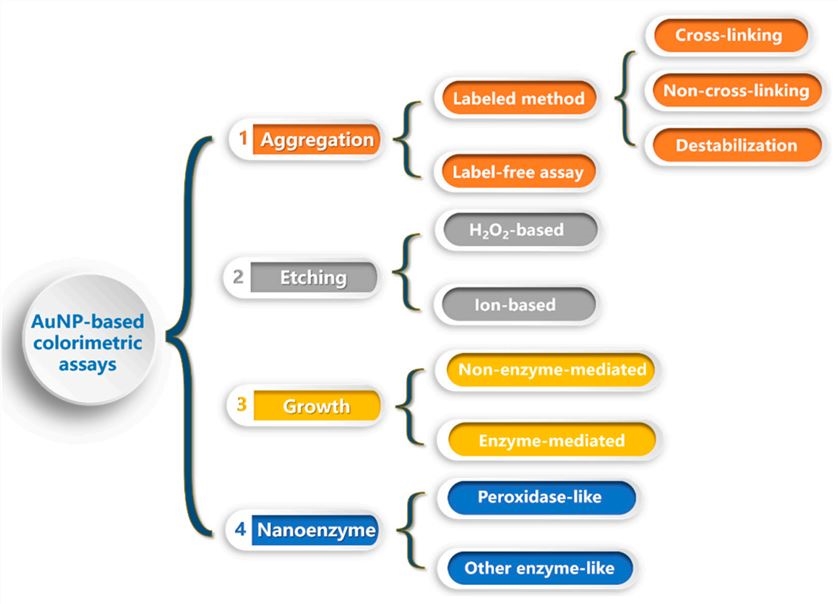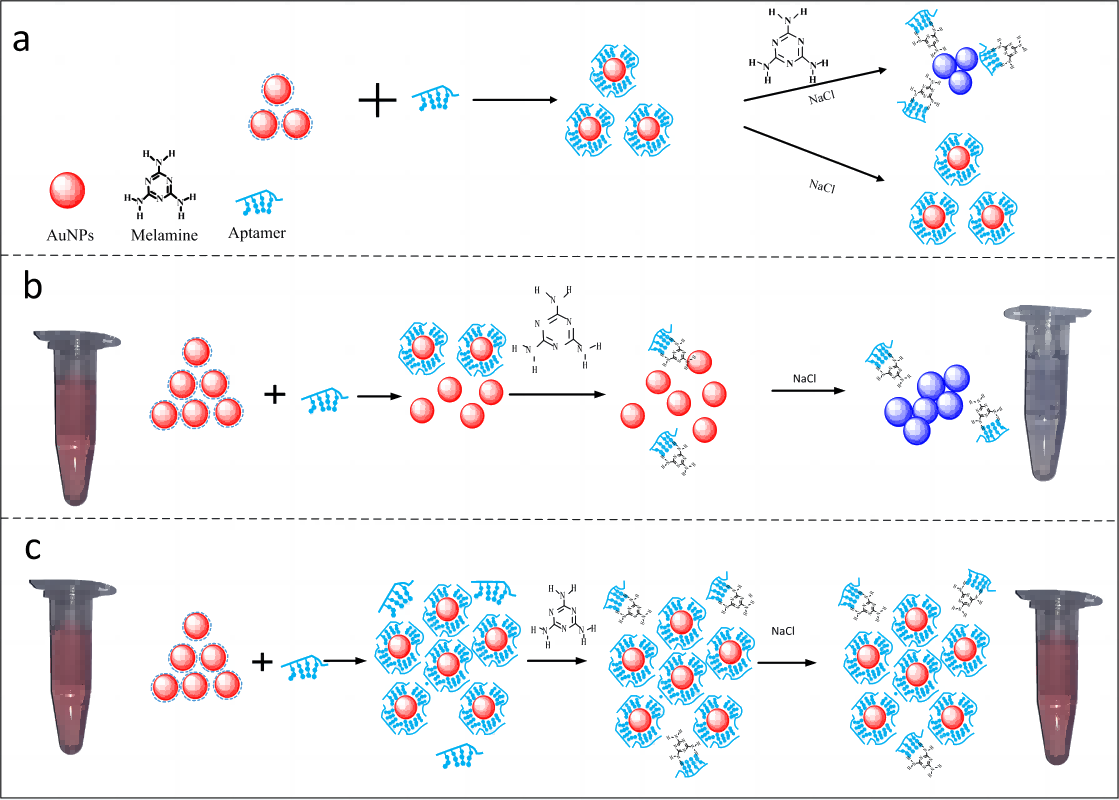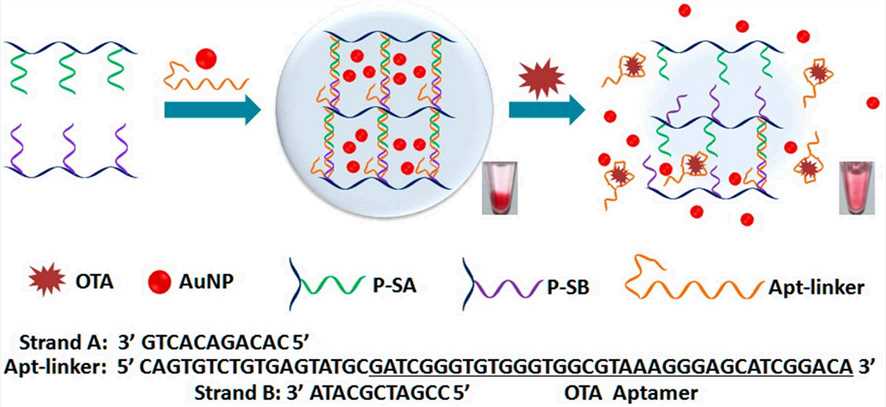Aptamers are specific short single stranded oligonucleotides (ONs) that are selected via systematic evolution of ligands by SELEX method. Compared to traditional recognition molecules, aptamers are more ideal molecular receptors and sensing elements for constructing sensing platforms. Based on its incomparable advantages, aptasensors of various performances have been excavated, such as surface plasmon resonance, quartz-crystal microbalance, fluorescence, electrochemistry and colorimetry. Among them, gold nanoparticles (AuNPs) based colorimetric aptasensors have fascinated interests in the visual detection of relevant analytes in various fields due to their unique optical properties and extremely high extinction coefficients. Different types of gold nanomaterial-based colorimetric sensors is summarized in Figure 1.
 Fig.1 Various gold nanomaterial-based colorimetric sensor types.1, 4
Fig.1 Various gold nanomaterial-based colorimetric sensor types.1, 4
Gold AuNPs Based Colorimetric Aptasensors
By bringing into full play the unique properties that both aptamer and AuNPs sensors have to offer, scientists have designed multifunctional colorimetric aptasensor platforms for optical recognition of various targets based on the assembly of aptamer and AuNPs. Colorimetric aptasensors are highly advantageous as the experimental results can be directly observed or quantified by analyzing visual color changes via naked eye, spectrophotometer or mobile phone chromatism without complex equipment. 5’-end of the different aptamer sequences were used, preferably for immobilization purposes. The specificity of the used aptamer sequences towards their analytes was verified by testing their sensitivity against possible interfering or structurally similar substances.
Colorimetric AuNPs -based aptasensors for detection of antibiotics
The combination of AuNPs and aptamers have been broadly used to fabricate colorimetric aptasensors for optical detection of antibiotics. Scientists applied ssDNA aptamer, with high specificity for kanamycin that was adsorbed onto the surface of AuNPs through electrostatic interaction. In the presence of kanamycin, aptamer attached to kanamycin and left the AuNPs surface. Addition of NaCl led to aggregation of AuNPs through shielding the negative charge of AuNPs and the color of sample changed from red to blue.
 Fig.2 A colorimetric assay for melamine utilizing aptamer-conjugated gold nanoparticles.2, 4
Fig.2 A colorimetric assay for melamine utilizing aptamer-conjugated gold nanoparticles.2, 4
Colorimetric AuNPs-based aptasensors for detection of toxins
Ochratoxin A (OTA) is a toxinand secondary metabolite of fungi commonly found in foodstuffs. Scientists designed a colorimetric detection system using AuNPs functionalized with a label-free aptamer to detect OTA. In the presence of OTA, the OTA aptamer changed its random coil structure to bind to the analyte. Addition of PDDA as a cationic polymer triggered the aggregation of AuNPs, leading to a change in the color system from wine-red to blue.
 Fig.3 Diagram of an AuNP-DNA hydrogel-based colorimetric aptasensor for OTA identification.3, 4
Fig.3 Diagram of an AuNP-DNA hydrogel-based colorimetric aptasensor for OTA identification.3, 4
Colorimetric AuNPs-based aptasensors for detection of bacteria
A high specific and sensitive colorimetric aptasensor was developed for detection of Staphylococcus aureus (S. aureus) by tyramine signal amplification. Schematic illustration of the work principle is shown in Figure 3. This detection approach could potentially be used for the detection of any analyte as long as the aptamers directed against were available.
Colorimetric AuNPs-based aptasensors for detection of parasite
A colorimetric aptasensor for sensitive and specific detection of Plasmodium lactate dehydrogenase (pLDH) in malaria was developed on the interaction of pLDH with ssDNA PL1 aptamer. In the absence of pLDH, aptamer attached to cationic polymers such as PDDA or PAH and could inhibit the aggregation of AuNPs by cationic polymers, resulting in a red color in the sample. When pLDH was present, aptamer interacted with pLDH, leading to aggregation of AuNPs by cationic polymer.
Summary
AuNPs have obtained great attention as colorimetric reporters, due to their high extinction coefficients, ease of synthesis, and strongly distance-dependent optical characteristics. Colorimetric AuNP-based-aptasensors have gained considerable attention for detection of various targets because the molecular recognition events can be easily detected by the naked eyes without the need for any sophisticated equipment. So, colorimetric AuNPs-aptasensors have great potential as commercial diagnostic tools.
References
- Chang, Chia-Chen, et al. "Gold nanoparticle-based colorimetric strategies for chemical and biological sensing applications." Nanomaterials 9.6 (2019): 861.
- Hu, Xinran, et al. "Aptamer-functionalized AuNPs for the high-sensitivity colorimetric detection of melamine in milk samples." PLoS One 13.8 (2018): e0201626.
- Guo, Xiaodong, et al. "Aptamer-based biosensor for detection of mycotoxins." Frontiers in Chemistry 8 (2020): 195.
- Distributed under Open Access license CC BY 4.0, without modification.
For Research Use Only.

